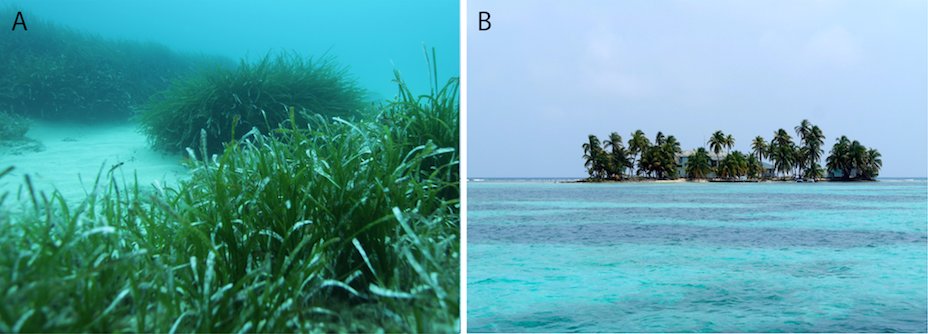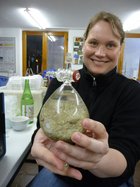- Press Office
- High versus low fidelity in symbioti...
High versus low fidelity in symbiotic relationships: Some bacteria have it both ways
High versus low fidelity in symbiotic relationships: Some bacteria have it both ways
Different hosts with similar tenants
Nematodes and annelids. These are roundworms and segmented worms. They are just worms, one might think. „In fact, these two animal phyla are about as different as men and turtles”, says Judith Zimmermann from the Max Planck Institute for Marine Microbiology in Bremen, Germany. „And yet they live in symbiosis with very closely related bacteria.” This flexibility of symbionts of marine worms has now been described in a publication in Molecular Ecology.
The symbiotic tenants of roundworms and segmented worms belong to a group of closely related bacteria named Candidatus Thiosymbion. These bacteria supply their hosts with nutrition. In the roundworms – in a subfamily called Stilbonematinae -, they live as ectosymbionts. “The bacteria cover the worm like a sleeping bag, only the head and the tip of the tail peek out”, Zimmermann explains. In contrast, in segmented worms – in the gutless oligochaetes –, the bacteria live as endosymbionts underneath the worms’ skin and feed their host so well that they have lost their mouth and gut.
„Our results show that these symbiotic bacteria appear to have switched multiple times between roundworms and segmented worms and accordingly between ecto- and endosymbiotic lifestyles during the course of their evolution“, Zimmermann explains. „This flexibility is remarkable, because bacteria are generally adapted to one type of lifestyle and one group of hosts“, adds joint author Cecilia Wentrup. „It was the large amount of data we analysed during this study that allowed us to reconstruct the closely interwoven evolution of these symbionts and their marine hosts.”
Despite their remarkable flexibility, however, the symbionts are very true loyal to their hosts in some concerns. Once again, Zimmermann and her colleagues were in for a surprise. Contrary to Zimmermann and her colleagues their expectations, the external tenants seem to show more long-term loyalty to their hosts than the internal cohabitants. „Long-term means over millions of years“, Zimmermann clarifies. „The host-symbiont-relationship is very stable for the roundworms and their bacteria. Apparently, they have co-evolved with each other without changing their partner.” Closely related roundworms were always associated with closely related symbionts. This high fidelity was seen in hosts from around the world, whether Zimmermann and her colleagues looked at roundworm-bacteria associations from Sylt, the Caribbean, the Mediterranean or Australia.
The picture is different in the symbiosis between segmented worms and their bacteria. „Relationships were much less stable in these associations“, Wentrup explains. “In the segmented worms, not only the host species plays a role.” Rather, the location is also important. The researchers often found that distantly-related host species from the same geographic region had very similar symbionts. And vice-versa, closely related hosts from different geographic regions often had only distantly-related symbionts. „Closely related segmented worms from Australia and the Caribbean, for example, do not always have closely related symbionts”, Wentrup adds. “This suggests that in the segmented worms, the original bacterial symbionts were often replaced by local bacteria.“
The results of this study clearly show how flexible and full of surprises marine symbioses are. “Next we plan to investigate what determines the lifestyles of these symbionts“, says Nicole Dubilier, senior author of the present study and Director at the Max Planck Institute for Marine Microbiology. Which factors decide whether the Candidatus Thiosymbion-bacteria remain external and attached to the surfaces of their hosts or become internal and live under the worms’ skin? How do host and symbionts recognize each other? And do ectosymbionts become endosymbionts, or the other way round? Zimmermann, Wentrup and colleagues are looking forward to figuring out the answers to these questions and many more.


Judith Zimmermann, Cecilia Wentrup, Miriam Sadowski, Anna Blazejak, Harald R. Gruber-Vodicka, Manuel Kleiner, Jörg A. Ott, Bodil Cronholm, Pierre De Wit, Christer Erséus, Nicole Dubilier: Closely coupled evolutionary history of ecto- and endosymbionts from two distantly related animal phyla. Molecular Ecology. DOI: 10.1111/mec.13554
Please direct your queries to:
Head of Press & Communications
MPI for Marine Microbiology
Celsiusstr. 1
D-28359 Bremen
Germany
|
Room: |
1345 |
|
Phone: |


